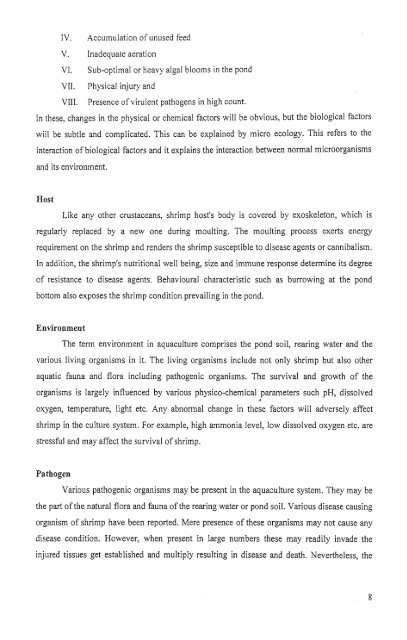, Diagnosis an-&& of Shrimp Diseases - Central Institute of ...
, Diagnosis an-&& of Shrimp Diseases - Central Institute of ...
, Diagnosis an-&& of Shrimp Diseases - Central Institute of ...
- No tags were found...
You also want an ePaper? Increase the reach of your titles
YUMPU automatically turns print PDFs into web optimized ePapers that Google loves.
IV. Accum~ilation <strong>of</strong> unused feedV. Inadequate aerationVI. Sub-optimal or heavy algal blooms in the pondVII. Physical injury <strong>an</strong>dVIII. Presence <strong>of</strong> virulent pathogens in high count.In these, ch<strong>an</strong>ges in the physicaI or chernicaI factors will be obvious, but the biological factorswill be subtle <strong>an</strong>d complicated. This c<strong>an</strong> be explained by micro ecology. This refers to theinteraction <strong>of</strong> biological factors <strong>an</strong>d it explains the interaction between normal microorg<strong>an</strong>isms<strong>an</strong>d its environment.HostLike <strong>an</strong>y other crustace<strong>an</strong>s, shrimp host's body is covered by exoskeleton, which isregularly replaced by a new one during moulting. The moulting process exerts energyrequirement on the shrimp <strong>an</strong>d renders the shrimp susceptible to disease agents or c<strong>an</strong>nibalism.In addition, the shrimp's nutritional well being, size <strong>an</strong>d immune response determine its degree<strong>of</strong> resist<strong>an</strong>ce to disease agents. Behavioural characteristic such as burrowing at the pondbottom also exposes the shrimp condition prevailing in the pond.EnvironmentThe term environment in aquaculture comprises the pond soil, rearing water <strong>an</strong>d thevarious living org<strong>an</strong>isms in it. The living org<strong>an</strong>isms include not only shrimp but also otheraquatic fauna <strong>an</strong>d flora including pathogenic org<strong>an</strong>isms. The survival <strong>an</strong>d growth <strong>of</strong> theorg<strong>an</strong>isms is largely influenced by various physico-chemical parameters such pH, dissolvedoxygen, temperature, light etc. Any abnormal ch<strong>an</strong>ge in these factors will adversely affectshrimp in the culture system. For example, high ammonia level, low dissolved oxygen etc. arestressful <strong>an</strong>d may affect the survival <strong>of</strong> shrimp.PathogenVarious pathogenic org<strong>an</strong>isms may be present in the aquaculture system. They may bethe part <strong>of</strong> the natural flora <strong>an</strong>d fauna <strong>of</strong> the rearing water or pond soil. Various disease causingorg<strong>an</strong>ism <strong>of</strong> shrimp have been reported. Mere presence <strong>of</strong> these org<strong>an</strong>isms may not cause <strong>an</strong>ydisease condition. However, when present in large numbers these may readily invade theinjured tissues get established <strong>an</strong>d multiply resulting in disease <strong>an</strong>d death. Nevertheless, the
















